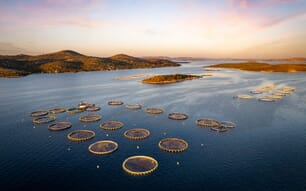 At the CAA2 Intervet booth. From left: Zhao Shuang, Alistair Brown, Dr. Brian Sheehan and Dr. Zilong Tan At the CAA2 Intervet booth. From left: Zhao Shuang, Alistair Brown, Dr. Brian Sheehan and Dr. Zilong Tan |
A strong team from Intervet was present, participating in the scientific session, expert panel and exhibition. The team members were Alistair Brown (Intervet International bv), Dr. Brian Sheehan and Dr. Zilong Tan (Intervet Norbio Singapore), and Zhao Shuang (Intervet Hong Kong) (see photo). Intervet and collaborators presented five scientific papers, including one as keynote presentation (see abstract below; for the full paper, contact info.aquaINS@intervet.com). Zilong and Brian also chaired the disease session.
Dr. Leong Tak Seng (co-authored with Intervet) from Malaysia presented a paper entitled Impact of infection with capsalid monogeneans in marine fish cultured in Asia. He pointed out that many capsalid monogeneans, mainly Benedenia epinepheli, B. lutjani and Neobenedenia girellae (N. melleni), infected marine fish all year round. Among them, N. girellae appeared to cause the greatest economic losses, at least in the S.E. Asian region. The high density of the monogenean population in the cage culture ecosystem is the direct cause of the parasitic disease outbreaks. Improved farming practices, and prevention and control measures must be used to tackle the problem. Reduction in stocking density, frequent cleaning of cage nets, application of antifouling paint and use of pelleted feed can decrease the incidence of parasitic infection. More research needs to be done on developing products for prevention and/or treatment.
A study that monitored the health status of marine fish in Asia was conducted by Dr. An xing Li and colleagues from Sun Yat sen University in Guangzhou, and Intervet Singapore. This epidemiological survey on a variety of farmed fish studied the prevalence of viral, bacterial and parasitic diseases during the July 2003 to April 2006 period, and found that 84% of fish (mostly clinically abnormal) were infected with one or more pathogens. Several species were co infected with multiple pathogens. Bacterial pathogens identified included Streptococcus iniae, S. dysgalactiae, Pasteurella damsela subsp. piscicida, Nocardia seriolae and Tenacibaculum maritimum. Parasites were monogenean trematodes and Cryptocaryon irritans. The authors called for improvements in the farming environment and health management practices.
Ms. Xiaoli Yu from Guangxi Institute of Fisheries, in collaboration with Intervet, gave a presentation entitled: Trial vaccination of channel catfish Ictalurus punctatus with a live attenuated vaccine against enteric septicemia of catfish in China. Confirming data from the USA where the vaccine, Aquavac-ESC, has been already marketed for several years, the results indicated that the vaccine was safe and ELISA data showed that it could stimulate the immune system of channel catfish to produce specific antibodies, even in the fry stage. The feed conversion rate of the vaccinated group was 16.0% better than that of the control group. It suggests that proper application of Aquavac-ESC would provide economic benefits to the farmers.
In his presentation on the global success of the salmon industry in Norway, Alistair Brown (co authored with Dr. William Enright, both from Intervet International) said that, with the use of vaccination programmes, 5.6 million tonnes of salmon were produced during the period from 1986 to 2005. This figure would be only about 3.6 million tonnes without vaccines. Translated into value, the extra 2 million tonnes equaled USD 8 billion at current salmon prices. He also emphasized the reductions in the use of antibiotics as a result of vaccination and the overall improvement of health management practices. Although it was emphasized that vaccination had a major role in the salmon success story, concurrent developments with feeds, culture operations, marketing, etc. also contributed.


